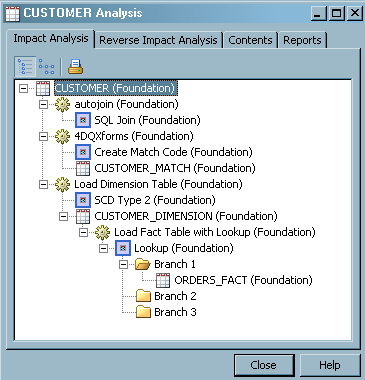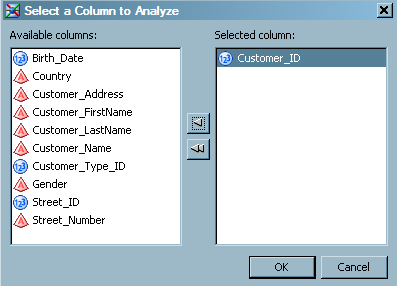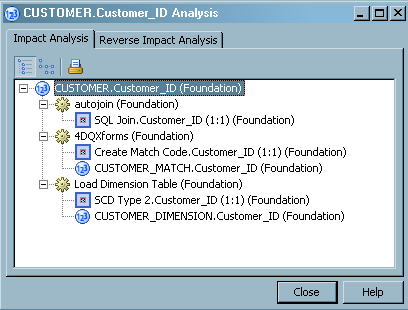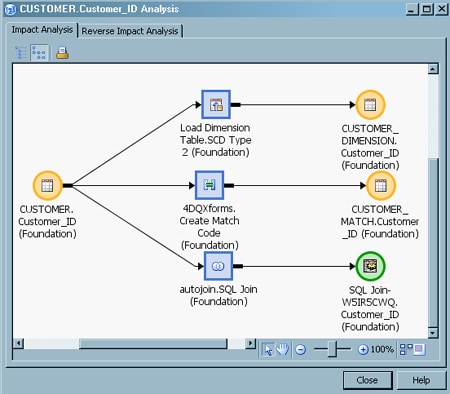Performing an Impact Analysis
Problem
A table is used in the process flow for a job. You want to delete the metadata for a column in a table, and you want to trace the
impact this would have on later objects in the process flow.
Solution
Use impact analysis to trace the impact of the selected object on later objects in the process flow for
the job.
Tasks
Perform an Impact Analysis
To perform impact analysis on a metadata object, right-click the object in a tree view or in a process flow in the Job Editor window,
and then select Analyze from the pop-up menu. Be sure to save the job in the Job Editor window
before running analysis on a metadata object in that job. Otherwise,
your analysis does not reflect any changes since the last save.
Alternatively, you can
select the object in a tree view or in the context of a process flow,
select Actions from the menu bar, and then
select Analyze. The following display shows
the tree view of the analysis of a table named CUSTOMER.
Impact Analysis Tab

Perform the following
steps to trace the impact of the metadata for a table column:
-
In a tree view or in the context of a process flow, right-click on the metadata object for the table that contains the column to be analyzed. Select Analyze.
-
In the Analyze window, right-click on the metadata object for the table, and then select Analyze Columns.
-
Select the column that you want from the Available columns pane. Use the arrow key to move it to the Selected column pane.Select a Column to Analyze Window

-
Click the OK button. A new window appears. In the following display, this window shows the result of an analysis performed on a column named Customer_ID in a table named CUSTOMER.Analysis Results
 The Tree View window uses a hierarchical list to illustrate the impact of the selected object (Customer_ID column) on later objects in a process flow. In the previous display, the tab contains three jobs. In this example, the third job contains the following objects:
The Tree View window uses a hierarchical list to illustrate the impact of the selected object (Customer_ID column) on later objects in a process flow. In the previous display, the tab contains three jobs. In this example, the third job contains the following objects:-
CUSTOMER.Customer_ID (Foundation): specifies the selected column, Customer_ID, in the table CUSTOMER, which is registered in the Foundation repository.
-
Load Dimension Table (Foundation): specifies the job, Load Dimension Table, to which the Customer_ID column is an input. The mapping type is 1:1.
-
SCD Type 2 Loader.Customer_ID (1:1) (Foundation): specifies the transformation that maps data from the Customer_ID column to a column later in the process flow. The mapping type is 1:1.
-
CUSTOMER_DIM.Customer_ID (Foundation): specifies the target column, Customer_ID, in the table CUSTOMER_DIM. The target column is loaded with data from the selected column.
-
-
To view the results as a graphical display, click on the icon for the Diagram View. The same analytical results as shown in the preceding hierarchical display are shown in the following graphical example.Analysis Diagram View
 The Diagram View uses a process flow to illustrate the impact of the selected object (Customer_ID column) on later objects in the flow.
The Diagram View uses a process flow to illustrate the impact of the selected object (Customer_ID column) on later objects in the flow.
Copyright © SAS Institute Inc. All Rights Reserved.
Last updated: January 16, 2018